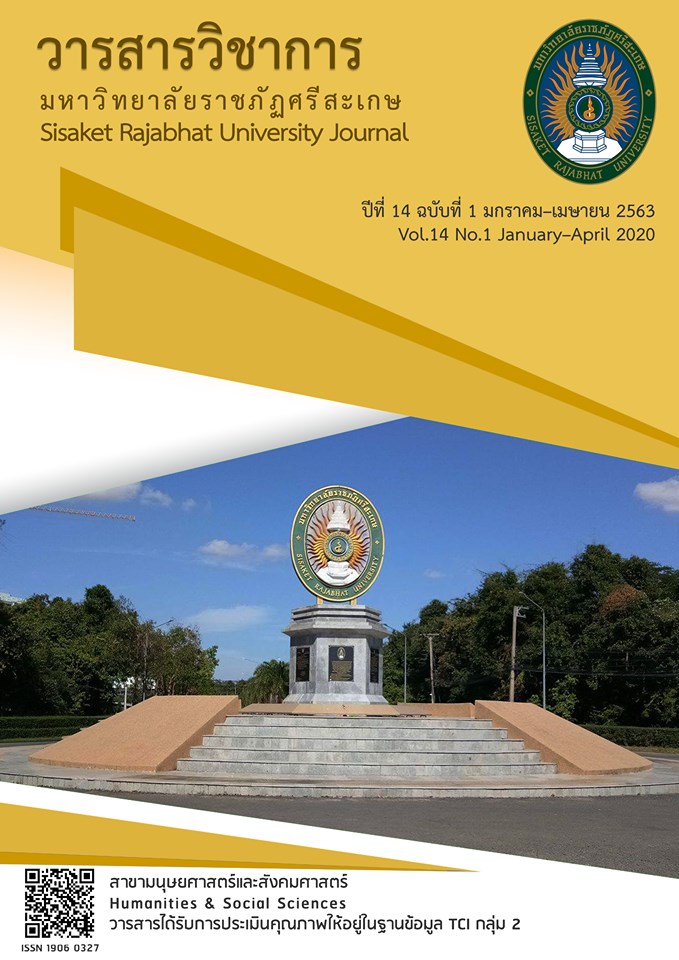ฐานะและความสำคัญของชุมชนหมู่บ้านปราสาทเยอ อำเภอไพรบึง จังหวัดศรีสะเกษ (พ.ศ.2265 - 2561)
Main Article Content
บทคัดย่อ
บทความนี้ศึกษาถึงฐานะและความสำคัญและการเปลี่ยนแปลงของชุมชนหมู่บ้านปราสาทเยอ อำเภอไพรบึง จังหวัดศรีสะเกษ ระหว่าง พ.ศ. 2265 ถึง พ.ศ.2561 จากการศึกษาพบว่า ชุมชนบ้านปราสาทเยอมีพื้นฐานความสำคัญจากการอยู่ในพื้นที่เหมาะทางภูมิศาสตร์ เป็นจุดเชื่อมต่อกับพื้นที่ต่าง ๆ โดยเฉพาะทางตอนใต้และตอนเหนือของจังหวัดศรีสะเกษ ประกอบกับพื้นที่มีทรัพยากรธรรมชาติจำนวนมาก ทำให้มีผู้คนเข้ามาอยู่อาศัยและเดินทางผ่านไปมาโดยตลอดตั้งแต่การเข้ามาของวัฒนธรรมขอมโบราณ เห็นจากศาสนสถานที่เรียกว่า “ปราสาทเยอ” รวมถึงบทบาทผู้นำท้องถิ่น และการที่ปัจจัยจากภายนอกที่มีผลต่อชุมชน
ในสมัยอยุธยา บริเวณชุมชนนี้เป็นพื้นที่การตั้งถิ่นฐานของชาวเยอที่อพยพมาจากตอนใต้ของประเทศลาวในราว พ.ศ. 2265 จนกระทั่งในสมัยรัตนโกสินทร์ชุมชนบ้านปราสาทเยอเป็นส่วนหนึ่งของหัวเมืองเขมรป่าดงและเมืองศรีสะเกษ เป็นแหล่งอาหารและกำลังเพื่อขยายอิทธิพลสู่เขมรและอีสานเหนือด้วย เนื่องจากมีทรัพยากรธรรมชาติที่หลากหลาย จนกระทั่ง พ.ศ. 2461 มีการสร้างวัดที่เป็นพื้นที่เดิมของ “ปราสาทเยอ” นั่นคือวัด “ปราสาทเยอเหนือ” โดยมีหลวงปู่มุม อินฺทปญฺโญ (พระครูประสาธน์ขันธคุณ) เป็นเกจิอาจารย์ที่ชาวศรีสะเกษให้ความเคารพนับถือมากที่สุดจำวัดอยู่ และใน พ.ศ. 2514 ชาวจังหวัดศรีสะเกษได้รับพระมหากรุณาธิคุณจากพระบาทสมเด็จพระบรมชนกาธิเบศร มหาภูมิพลอดุลยเดชมหาราช บรมนาถบพิตร และสมเด็จพระเจ้าสิริกิติ์ พระบรมราชินีนาถ พระบรมราชชนนีพันปีหลวง ในการเสด็จเยี่ยมพสกนิกรในชุมชนหมู่บ้านปราสาทเยอ ซึ่งในการเสด็จฯ ครั้งนั้นทำให้ชุมชนหมู่บ้านปราสาทเยอเป็นที่รู้จักของประชาชนทั่วไปมากขึ้น ซึ่งเป็นการเพิ่มบทบาทของความสำคัญของชุมชนบ้านปราสาทเยอในฐานะพื้นที่ศักดิ์สิทธิ์ทางพระพุทธศาสนาและพื้นที่ ๆ สถาบันพระมหากษัตริย์ได้เคยเสด็จพระราชดำเนินเยือน
ภายหลังการเสด็จพระราชดำเนินเยือนใน พ.ศ. 2514 ชุมชนหมู่บ้านปราสาทเยอยังคงความสำคัญในฐานะชุมทางการคมนาคมที่มีถนนผ่านหลายสายโดยเชื่อมถึงถนนหลักหมายเลข 24 (สีคิ้ว-เดชอุดม) และถนนเชื่อมต่อถึงตัวอำเภอเมืองศรีสะเกษ ทำให้ชุมชนหมู่บ้านปราสาทเยอเจริญเติบโตอย่างต่อเนื่อง โดยถูกยกฐานะเป็นหมู่บ้านและการท่องเที่ยวตามนโยบายของรัฐบาลใน พ.ศ. 2561 ส่งผลต่อวิถีของผู้คนในชุมชนหมู่บ้านปราสาทเยอให้เกิดความเปลี่ยนแปลงไปจากเดิม ยิ่งไปกว่านั้น ชุมชนหมู่บ้านปราสาทเยอยังเป็นแบบอย่างของการผสมผสานกันในทางสังคมและวัฒนธรรมเขมรและวัฒนธรรมแบบพุทธศาสนาของคนท้องถิ่นด้วย
Article Details
1. เนื้อหาและข้อมูลในบทความที่ลงตีพิมพ์ในวารสารวิชาการมหาวิทยาลัยราชภัฏศรีสะเกษ ถือเป็นข้อคิดเห็นและความรับผิดชอบของผู้เขียนบทความโดยตรง ซึ่งกองบรรณาธิการวารสาร ไม่จำเป็นต้องเห็นด้วย หรือร่วมรับผิดชอบใด ๆ
2. บทความ ข้อมูล เนื้อหา รูปภาพ ฯลฯ ที่ได้รับการตีพิมพ์ในวารสารวิชาการมหาวิทยาลัยราชภัฏศรีสะเกษ กองบรรณาธิการไม่สงวนสิทธิ์ในการคัดลอกบทความเพื่อการศึกษา แต่ให้อ้างอิงแหล่งที่มาให้ครบถ้วนสมบูรณ์
เอกสารอ้างอิง
Chuaibamrung, T. (2010). South Isan tourism dynamics: searching for contemporary smiles of time through research. Bangkok: Thailand Research Fund (TRF). [In Thai]
Culture, development in history, identity, and wisdom of Sisaket Province. (2001). Bangkok: Kurusapa Printing Press. [In Thai]
Kluenfung, P. (2008). Royal proceeding to the provincial areas of His Majesty King Bhumibol Adulyadej during 1950 - 1987. Thesis of M.A. (History). Bangkok: Graduate School. Chulalongkorn University. Photocopying. [In Thai]
Kongsap, S. (1993). Importance of Khukan, Sangha and Surin Districts, 1759-1907. Thesis of M.A. (History). Maha Sarakham: Srinakharinwirot University. Maha Sarakham. Photocopying. [In Thai]
Lohitkun, Th and Natjamnong, Th. (2018). Travel Guide to Thewalai of South Isan with E-shann Ways Magazine. Bangkok: E-shann Ways Co., Ltd. [In Thai]
Nanthachak, A. (2007). Local history and tourism. Ubon Ratchathani: Ubon Ratchathani University Press. [In Thai]
Nilkamhang, P. (1993). Key factors affecting the cultural assimilation of Kuoyyoe people in Sisaket Province. Thesis of M.A. (Geography) Bangkok: Graduate School. Srinakharinwirot University. Photocopying. [In Thai]
Prasat Yoe Village. (2019). From https://www.google.com/maps/place/Ban Prasat School. [In Thai]
Silabut, P. (1997). Yoe in Sisaket: Past, Present and Future. Sisaket: Sisaket Rajabhat University Photocopying. [In Thai]
Silabut, P. et al. (2007). A study of man-made tourist sites in the group of South Isan provinces.: Sisaket Rajabhat University. Photocopying. [In Thai]
Sisaket Educational Research Center, Sisaket Rajabhat University. (2007). Prasat Yoe Village: Cultural Sites of the Past where His Majesty the King proceeded to offer the Royal Kathin robes. Sisaket. Center. [In Thai]
Sisaket Provincial Office. (2006). History, culture and local wisdom: history of Districts, Sub-districts, and villages in Sisaket Province.
Sisaket: Office. [In Thai]
Sisaket Rajabhat University. (2007). Following in the King’s footsteps in Sisaket. Sisaket. University. [In Thai]
Sisaket Rajabhat University. (2011). Royal grace of His Majesty the King and his royal family towards people in Sisaket Province. Sisaket: University. [In Thai]
Sornpanya, S. (2001). Collection of ancient religious sites in Sisaket Province. Ubon
Ratchathani: YongSawat InterGroup. [In Thai]
Sornpanya, Ph. et al. (2015a). Sisaket, our province 1: history, social studies, religion and culture. Ubon Ratchathani: Yong Sawat Inter Group. [In Thai]
Sornpanya, Ph et al. (2015b). Sisaket, Our Province 2: geography, economy, transportation And the environment. Ubon Ratchathani: Yong Sawat Inter Group. [In Thai]
Suebwattana, Th. (2015). Concepts and guidelines for studying local history. Bangkok: Inthanin. [In Thai]
Wanliphodom, S. (1990). Northeast civilization source. Bangkok: Matichon. [In Thai]
Yoorungruangsak, N. (2011). Amulets and Thai society after World War II to 2007: a study of beliefs, models and Buddhist commerce. Thesis of M.A. (History Education): Nakhon Pathom: Graduate School, Silpakorn University. Photocopying. [In Thai]


